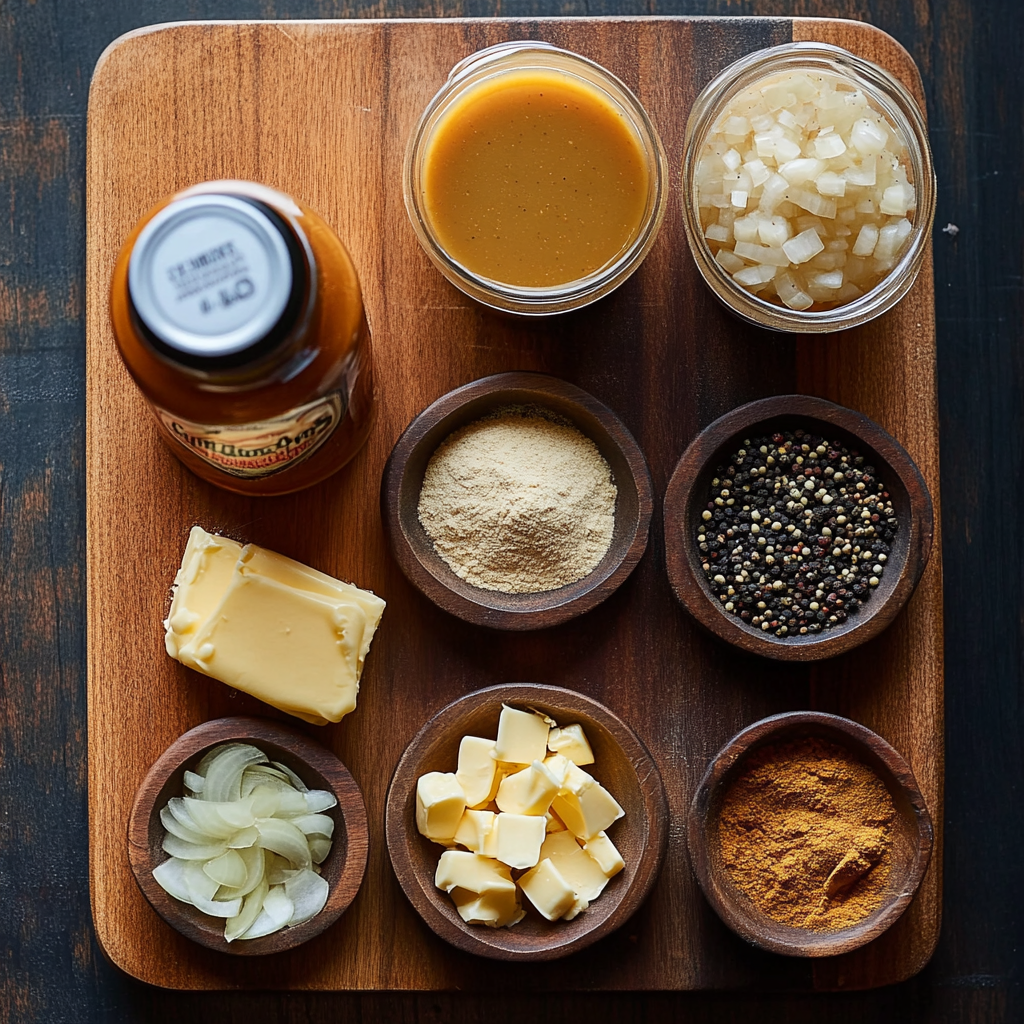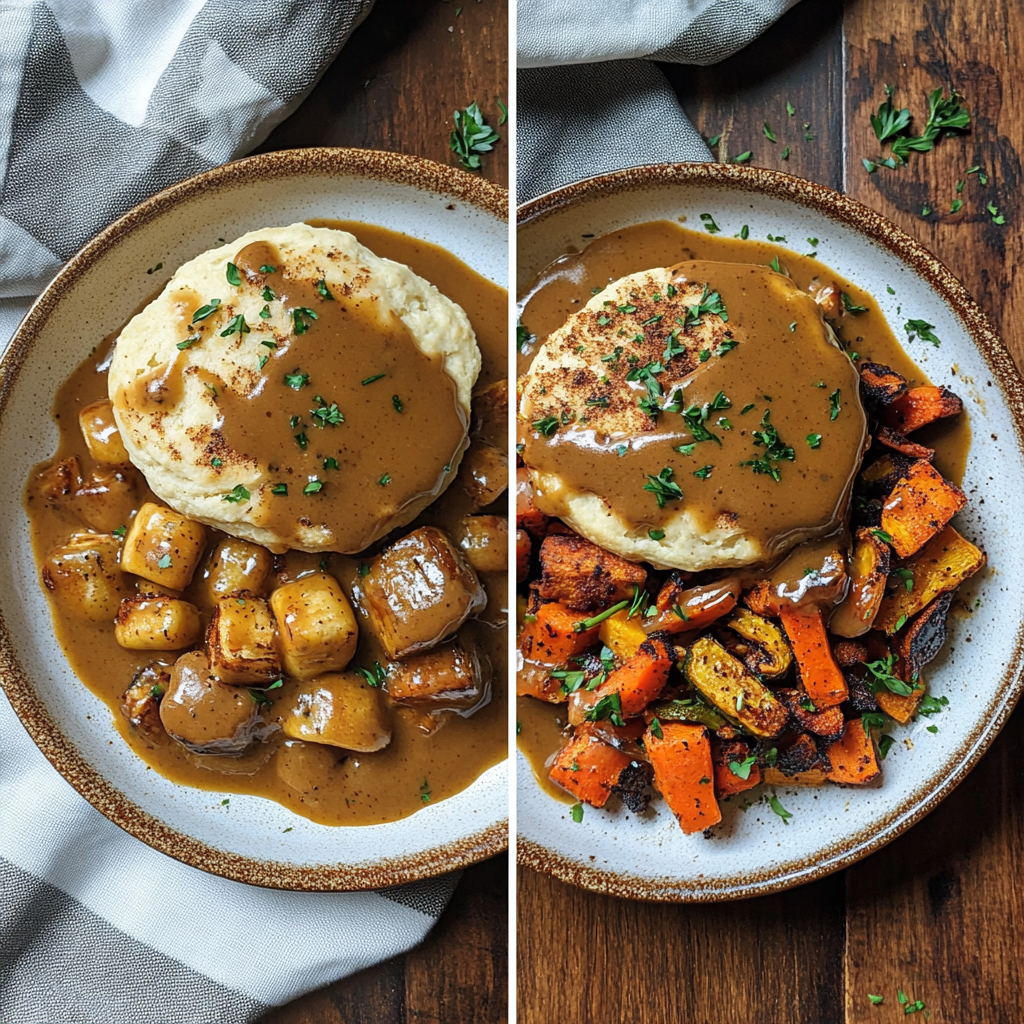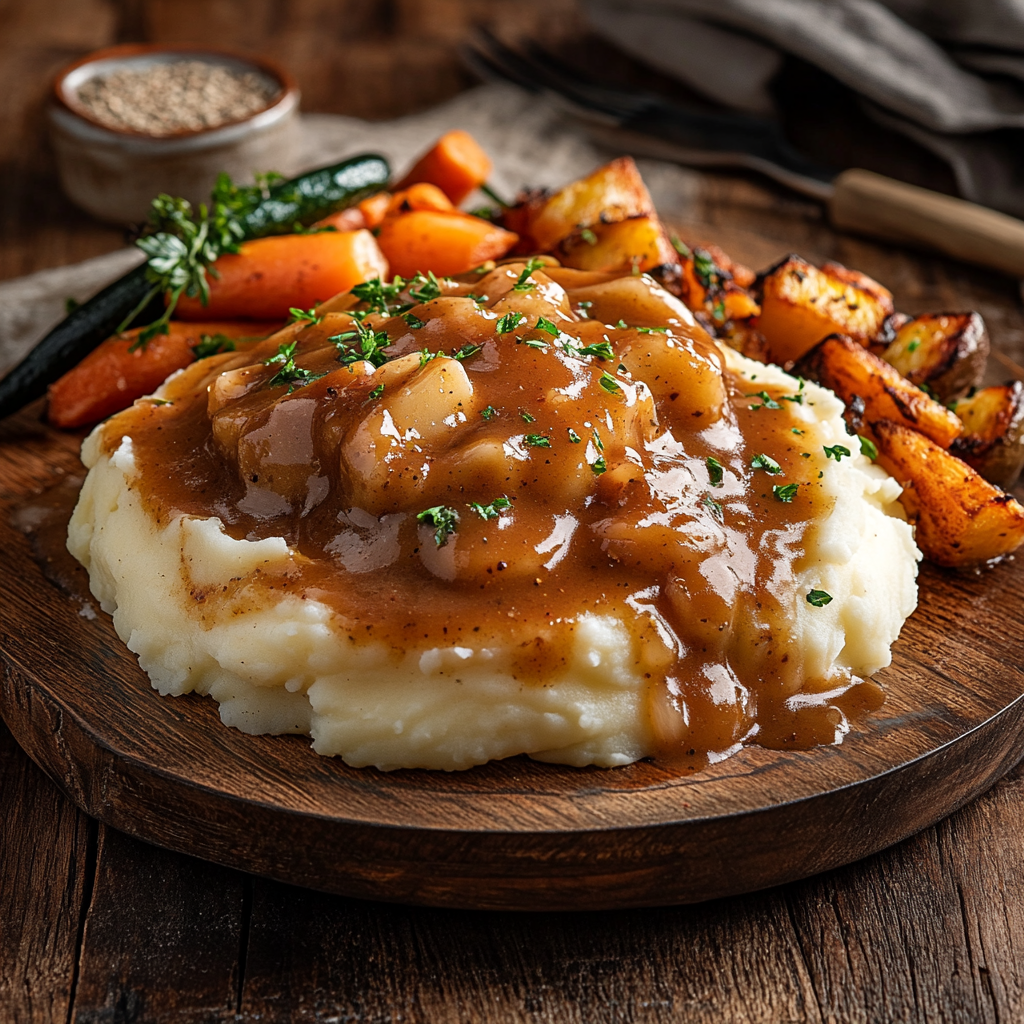When it comes to adding a bold Southern flair to any meal, Cajun gravy stands out as a showstopper. This deliciously spiced gravy recipe is a staple in Southern kitchens, thanks to its rich, savory flavor and versatile applications. Whether you’re drizzling it over mashed potatoes, biscuits, or roasted meats, Cajun gravy brings a burst of flavor to your table. And with simple swaps, you can easily make it gluten-free, vegan, or spicier, based on your preferences. If you’ve ever wondered how to make the perfect Cajun gravy from scratch, you’re in the right place!
For even more ideas on how to use this gravy with breakfast dishes like biscuits and scrambled eggs, check out our Breakfast section for some amazing Southern recipes.
Ingredients Overview: Everything You Need for the Perfect Cajun Gravy Recipe
Making Cajun gravy from scratch may sound intimidating, but with a well-curated list of ingredients, it’s a breeze. The key to this gravy recipe is the careful balance of fats, liquids, and spices that give it its signature smooth texture and robust flavor. Below, we’ll walk through the essential components, along with possible substitutions to cater to various dietary needs like gluten-free or vegan options.
Essential Ingredients for Cajun Gravy:
- Butter or Dairy-Free Butter: Butter forms the creamy foundation of this gravy, giving it a rich, silky texture. If you’re looking to make a vegan or dairy-free version, simply substitute butter with a plant-based alternative.
- All-Purpose Flour: Flour acts as the thickening agent in the gravy. For a gluten-free version, you can use rice flour or almond flour. However, all-purpose flour gives the gravy the traditional smooth texture you’re aiming for.
- Chicken Broth, Beef Broth, or Vegetable Broth: The choice of broth is crucial for the flavor profile. Chicken broth is the most commonly used for a traditional Cajun gravy recipe, but you can opt for beef broth for a deeper, meatier flavor or vegetable broth to keep it vegan.
- Cajun Seasonings: A Cajun gravy wouldn’t be complete without a well-balanced blend of Cajun spices. These typically include cayenne pepper, garlic powder, onion powder, and dried oregano. These seasonings give the gravy its distinct, spicy kick.
- Garlic and Onion: Freshly minced garlic and finely chopped onion add depth and dimension to the flavor of the gravy.
- Black Pepper and Salt: For seasoning, it’s always a good idea to adjust the amount of black pepper and salt according to your taste.
- Worcestershire Sauce: This ingredient enhances the umami notes in the gravy, making the flavors even richer and more complex.
- Optional Add-ins: To make the gravy heartier, you can add diced bell peppers, celery, or even sautéed ground pork. These ingredients will create a chunkier texture and a more substantial sauce.
For more inspiration on how to use these ingredients in other Southern dishes, browse through our Snacks section where we offer a variety of recipes that complement this gravy beautifully.

Tools Needed: Essential Equipment for Making Cajun Gravy at Home
Preparing the perfect Cajun gravy requires a few essential kitchen tools, and while none of them are particularly specialized, having the right equipment on hand can make all the difference. Below, we’ll outline the necessary tools to ensure a smooth cooking process from start to finish.
Must-Have Tools for Your Cajun Gravy Recipe:
- Medium Saucepan: A medium saucepan is ideal for making Cajun gravy, as it provides enough space for all the ingredients to combine without overcrowding. The even heat distribution in a saucepan helps to achieve the perfect golden brown roux, the base of your gravy.
- Whisk: A whisk is an essential tool for keeping your gravy smooth and lump-free. When combining the all-purpose flour with the melted butter, whisking continuously ensures the flour is evenly distributed, preventing clumps.
- Wooden Spoon: A wooden spoon is perfect for stirring the gravy as it thickens, particularly when you’re adding the broth and seasonings. The spoon’s sturdy texture helps scrape up any browned bits that form at the bottom of the pan, which are full of flavor.
- Measuring Cups and Spoons: Precise measurements are crucial in cooking, especially when working with a gravy recipe that requires a balance of liquid and flour. Using measuring cups and spoons ensures accuracy, which is important for consistency.
- Knife and Cutting Board: You’ll need these to finely chop the onion and mince the garlic. Properly chopped aromatics will blend seamlessly into the gravy, enhancing its flavor without leaving large chunks.
If you don’t have a whisk, you can use a fork as a substitute, but a whisk will always yield smoother results. If you lack a medium saucepan, a deep skillet can work as well, though a saucepan provides better heat control for this type of gravy.
For other recipes that use similar tools and techniques, visit our Dinner section where you’ll find hearty meal options that pair wonderfully with this spicy gravy.
Step-by-Step Instructions: How to Make Cajun Gravy From Scratch
Making Cajun gravy may sound complicated, but once you break it down step by step, it’s a simple and rewarding process. Below is a detailed guide that will take you through each stage, ensuring you achieve a smooth, flavorful gravy every time.
Step 1: Prepare Your Ingredients
Start by gathering and preparing all of your ingredients. Chop your onion finely and mince your garlic. This step is crucial, as freshly chopped garlic and onions add more flavor than pre-minced or dried alternatives. Also, measure out your Cajun seasonings, chicken broth (or beef broth/vegetable broth), all-purpose flour, and butter before you start cooking. This makes the process smoother and helps prevent mistakes.
Step 2: Melt the Butter and Create the Roux
Heat your medium saucepan over medium heat and melt the butter (or dairy-free butter, if making a vegan version). Once the butter is melted, slowly whisk in the all-purpose flour to form a roux. Stir constantly to avoid burning the flour. The roux is ready when it turns a golden brown color, which typically takes about 3-4 minutes. This roux forms the base of your Cajun gravy, giving it a deep, nutty flavor.
Step 3: Add Garlic, Onion, and Seasonings
Once the roux is golden, add your minced garlic and finely chopped onion. Stir them into the roux and let them sauté for 2-3 minutes until the onions become soft and translucent, and the garlic is fragrant. Then, stir in your Cajun seasonings, including cayenne pepper, garlic powder, onion powder, and dried oregano. Be sure to continue stirring to prevent burning.
Step 4: Slowly Incorporate the Broth
Next, slowly pour in your chicken broth, beef broth, or vegetable broth while whisking continuously to prevent lumps. The gravy will begin to thicken as the liquid incorporates with the roux. Keep stirring to maintain a smooth texture, and let the mixture simmer over medium heat for 5-7 minutes, allowing the flavors to meld.
Step 5: Add Worcestershire Sauce and Adjust Seasonings
For an extra burst of umami, stir in a teaspoon of Worcestershire sauce. Taste the gravy at this stage and adjust the seasoning if necessary. You may want to add a pinch of black pepper, extra salt, or a few dashes of hot sauce for more heat.
Step 6: Optional Add-ins for Extra Flavor
If you’d like a chunkier gravy, this is the time to add your optional ingredients, like diced bell peppers, celery, or even sautéed ground pork. These additions give the gravy a heartier, more textured consistency, perfect for serving over roasted meats or mashed potatoes.
Step 7: Serve and Enjoy
Remove the gravy from heat and let it cool slightly before serving. Whether you’re pouring it over fluffy mashed potatoes, crispy fried chicken, or warm biscuits, Cajun gravy adds a bold, flavorful kick to any dish.
For more delicious breakfast ideas that pair beautifully with this gravy recipe, check out our Breakfast section for Southern staples like fluffy biscuits or savory scrambled eggs.
Flavor Variations: Customize Your Cajun Gravy Recipe for Any Occasion
One of the most exciting aspects of Cajun gravy is how easily it can be adapted to fit your personal tastes or dietary needs. From a vegan option to spicing things up, this gravy can be tailored to any palate.
Vegan Cajun Gravy Recipe
To make a vegan version of Cajun gravy, replace the butter with a plant-based alternative, such as coconut oil or dairy-free butter. Instead of chicken broth, opt for vegetable broth. This version will still capture the bold flavor of the traditional Cajun seasonings, like cayenne pepper, garlic powder, and onion powder, while remaining completely plant-based.
Spicy Cajun Gravy Recipe
If you love heat, turn up the spice factor by adding extra Cajun seasonings or a few dashes of hot sauce. You can also increase the amount of cayenne pepper for a more intense flavor, or even add chopped jalapeños to the gravy for an extra fiery kick.
Herb-Infused Cajun Gravy
For a fresher, herb-infused gravy, add fresh thyme, rosemary, or parsley toward the end of cooking. This can help balance the spiciness of the Cajun spices with a lighter, more aromatic flavor.
Creamy Cajun Gravy
For a creamier version of Cajun gravy, stir in a splash of heavy cream or coconut milk just before serving. This creates a smoother, richer texture, making it a perfect topping for mashed potatoes or roasted meats.
For more Cajun-inspired dishes that complement this gravy, visit our Snacks section for a variety of Southern treats that pair beautifully with this spicy sauce.

Expert Tips for Making the Perfect Cajun Gravy
Even though Cajun gravy is relatively simple to prepare, there are a few tips and tricks that can help elevate your gravy-making skills to ensure you get a perfect result every time.
Tip 1: Don’t Rush the Roux
The roux is the foundation of any good gravy, and in Cajun gravy, the roux plays an especially important role. When melting the butter and whisking in the all-purpose flour, take your time to let the mixture cook slowly over medium heat. This is what gives the gravy its golden brown color and deep, nutty flavor. If you rush this step, your roux may not develop the richness needed for a flavorful gravy.
Tip 2: Whisk Continuously for a Smooth Gravy
When adding the chicken broth, beef broth, or vegetable broth to the roux, be sure to whisk constantly. This will help prevent lumps from forming in your gravy, ensuring a smooth, velvety texture. It’s especially important to do this while the broth is still cold, as the flour needs time to incorporate evenly into the liquid.
Tip 3: Adjust the Thickness to Your Preference
If your Cajun gravy turns out too thick, you can easily thin it out by adding a little extra broth. If it’s too thin, allow it to simmer for a few more minutes until it thickens to your desired consistency. Remember, gravy will thicken as it cools, so if it’s a bit runny while hot, it might reach the perfect consistency once it’s off the heat.
Tip 4: Add Worcestershire Sauce for Depth
One of the secret ingredients to a deeply flavorful Cajun gravy is Worcestershire sauce. This tangy, umami-rich sauce adds a layer of complexity to the gravy, making it richer and more savory.
Tip 5: Prepping in Advance
Cajun gravy can be made a day ahead and stored in the fridge. When you’re ready to serve, simply reheat it gently on the stove and whisk in a splash of broth if it has thickened too much during refrigeration. This is perfect if you’re preparing for a large meal and want to save some time on the day of serving.
Want to learn more about the cooking techniques behind gravies and sauces? Visit our Dinner section to explore more recipes that use similar techniques.
Nutritional Information: A Health-Conscious Look at Cajun Gravy
While Cajun gravy is known for its bold flavors, it can also fit into a health-conscious diet if prepared thoughtfully. Below is a breakdown of the nutritional content of this gravy recipe based on a serving size of ¼ cup (approximately).
- Calories: 120 kcal
- Fat: 10g (with healthier fats if you use plant-based butter or olive oil)
- Carbohydrates: 8g (adjust if using gluten-free flour)
- Protein: 2g
- Fiber: 1g
- Sodium: Varies depending on the broth and seasoning choices
- Vitamins: Cajun seasonings like cayenne pepper and garlic powder offer small amounts of vitamins A, C, and E, as well as antioxidants.
For a lighter version of this Cajun gravy recipe, you can substitute the butter with a heart-healthy fat like olive oil and reduce the sodium content by using a low-sodium vegetable broth or chicken broth.
For more in-depth information on the health benefits of ingredients like garlic, onions, and Cajun spices, check out this article that discusses their nutritional advantages.
Serving Suggestions: Pairing Cajun Gravy with Other Southern Dishes
Cajun gravy is a versatile addition to many dishes, adding layers of flavor to even the simplest of meals. Below are some pairing suggestions to get the most out of your gravy recipe.
Biscuits and Cajun Gravy
For a classic Southern breakfast, serve Cajun gravy over warm, flaky biscuits. The buttery biscuits absorb the spicy, savory flavors of the gravy, making for a hearty and satisfying meal.
Mashed Potatoes and Cajun Gravy
Nothing complements mashed potatoes like a rich, flavorful Cajun gravy. The creamy texture of the potatoes paired with the spicy gravy creates the ultimate comfort food experience.
Roasted Chicken or Turkey
Drizzle Cajun gravy over roasted chicken or turkey for a flavorful twist on classic poultry dishes. The bold Cajun seasonings in the gravy elevate the natural flavors of the meat.
Vegan Roasted Vegetables
If you’re looking for a plant-based option, pour Cajun gravy over a platter of roasted vegetables like carrots, sweet potatoes, or Brussels sprouts. The gravy adds a spicy, savory element that makes this a filling, satisfying vegan meal.
For more Southern-inspired pairing ideas, head over to our Dinner section for dishes that work beautifully with Cajun gravy.

Storage Tips: How to Keep Your Cajun Gravy Fresh
One of the benefits of making Cajun gravy is that it stores well, allowing you to make it in advance or save leftovers for another day. Here’s how to store and reheat it for best results.
Refrigeration
If you plan to use the gravy within the next few days, store it in an airtight container in the refrigerator. It will keep for up to 3 days. To reheat, simply warm the gravy in a saucepan over medium heat, stirring occasionally. If it thickens too much while cold, add a splash of chicken broth, beef broth, or vegetable broth to thin it back out to the desired consistency.
Freezing
Cajun gravy can also be frozen for longer-term storage. Transfer the cooled gravy into a freezer-safe container, leaving a bit of room at the top as the gravy will expand slightly when frozen. It will keep for up to 3 months in the freezer. To reheat, thaw it overnight in the refrigerator and then warm it up slowly in a saucepan, adding broth as needed to adjust the texture.
FAQs: Common Questions About Cajun Gravy
Q: Can I make Cajun gravy gluten-free?
A: Absolutely! To make a gluten-free version, simply substitute the all-purpose flour with a gluten-free flour such as rice flour or almond flour. The rest of the ingredients are naturally gluten-free.
Q: How do I store leftover Cajun gravy?
A: Leftover Cajun gravy can be stored in the refrigerator for up to 3 days in an airtight container. If you want to keep it longer, you can freeze it for up to 3 months. When reheating, add a little extra broth to achieve the desired consistency.
Q: What’s the best way to reheat Cajun gravy?
A: Reheat Cajun gravy in a saucepan over medium heat, stirring occasionally. If it has thickened too much in storage, simply add a splash of chicken broth or vegetable broth to bring it back to the right consistency.
For more FAQs on cooking techniques and storage tips, check out our Dinner section for similar content.
Conclusion: Why Cajun Gravy Should Be a Staple in Your Kitchen
Whether you’re serving it over mashed potatoes, biscuits, or roasted meats, Cajun gravy is a versatile and flavorful addition to your recipe collection. Its rich, bold flavors, derived from classic Cajun spices like cayenne pepper, garlic powder, and onion powder, make it a perfect complement to any meal, from breakfast to dinner. Plus, with its easy substitutions for vegan or gluten-free diets, it’s a dish that can be enjoyed by everyone.
